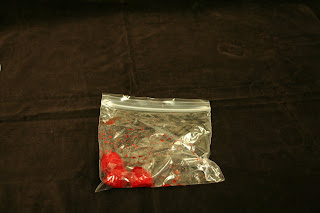This week's activity is a prime example of a natural phenomena that can provide hours of entertainment. Termites will follow the ink lines of Bic® ballpoint pens! All you need is a piece of paper, a termite, and a Bic® ballpoint pen and you'll have unlimited amounts of fun! Read on to learn more!
 Supplies:
Supplies: 1. Termites (there are a couple ways to go about obtaining them; order them from Carolina Biological Supply or a similar supplier, or you can go for a termite hunt!)
- If you choose to do the termite hunt option you will need an implement to pry or chop apart the decaying wood and expose the termites. We used a hammer, you could also use a screw driver or axe. As always, make sure you use proper precaution when using any tools with young children.
- This will also require that you have a container to store the termites in between the collection and experiment. Keep in mind live specimens are only viable for about 24 hours.
2. A variety of writing utensils
- At least one should be a Bic® ballpoint pen (blue ones specifically are rumored to be the best performer)
3. A paintbrush, toothpick, or other utensil with which to handle the termites
4. Plain Paper
5. A shallow box or tray to lay the paper in and contain the termites while experimenting
Below: Photos of what termites look like when found in the wild.


Procedure
- Collect/order your termites
- Draw your lines on your paper with multiple writing utensils. (keep in mind that they don't respond well to sharp turns or intersecting lines, circles and curvy lines work the best)
- Watch! Let the students discover what writing utensils the termites will follow.
- Reflect on which utensils the termites follow and the purpose of pheromones in termite colonies.
Below: You can see the two termites following the Bic® ballpoint pens are following their lines and the one near the Sharpie® line is not responding.

Watch the video from our experiment to get an idea of what to expect!
Follow Up Questions and Information
While the participants are making observations, you can ask them to call out their observations and record them to use when drawing conclusions at the end.
What's really going on here? The worker termites in this social insect species are blind. Pheromones, therefore, are a major form of commuication in the colony. When termites follow the pen lines, they are actually following a chemical in the pen ink that imitates this natural pheromone.
Participants will be amazed at the power these pens seems to exert over the termite. Ask youth to reflect on why the termites would exihibit this behavior. See if they can come up with other examples similar to pheromones or chemical signals.
Happy Trails!





















